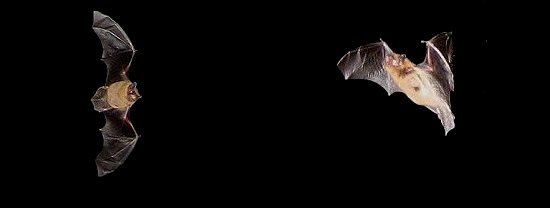
Coming Out to Bat
When bats first emerge from hibernation they're very hungry. Most of them won't have eaten for several months, and as an additional strain on their bodies, many of the females will be pregnant too. It's vital they eat well to ensure the survival of their developing young.
All the bats found in the UK feed on small insects like moths, midges, and gnats. Bats often appear to fly in erratic patterns, but they're usually chasing tiny flying insects which we can't see. They trap them in in their mouths or scoop them up with their tail or wing membranes.
Not Flying Mice
Despite the fears some people have of them, bats are surprisingly similar to ourselves, in fact in some areas they're a little further up the evolutionary scale. Being mammals they have hairy bodies just like us, and they suckle their young, just like us. They've also developed the ability to fly (with extreme precision) and see in the dark with their highly sensitive echo-location system.
Bat Watching Tips
The bat's nocturnal lifestyle makes them fairly difficult to observe, so for a good chance of seeing some you need to be out at dusk or dawn, as they begin and end their night flights. Look for areas where there are plenty of night-flying insects (areas near water are usually best). Pick an open spot where you can see bats silhouetted against the lighter sky.
Cheating!
An easy way to find bats is with a bat detector. These clever gadgets pick up the ultrasonic sounds made by bats and convert them into sounds we can actually hear.
This adds a whole new dimension to bat watching, and allows you to listen in on an otherwise secret world.
The sounds get stronger when you point the detector directly at the bat, so it's often possible to locate a bat by pointing the detector towards the strongest signal long before it can be seen. Each bat species emits a different frequency of ultrasound. By tuning the frequency dial on bat detector (just like a radio) you can identify which species you're watching.
Enjoy them While You Still Can
Interest in bats and bat watching is coming at a time when many species are in decline. Once numbers start to fall, bat populations find it very difficult to recover, since they produce only one baby a year. Insecticide poisoning, the closing of old caves, careless tree felling, disturbance of day roosts by people, or the destruction of roosting and maternity colonies by thoughtless property developers are the main threats to bats. You can help your local bats by keeping clear of roost sites and just enjoy watching, and listening to them when they're out flying.
- Bat Section
- Free Newsletter
